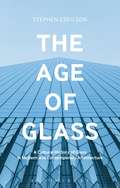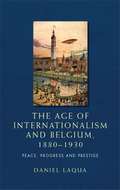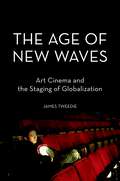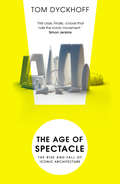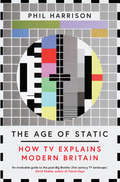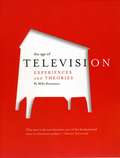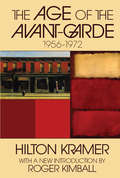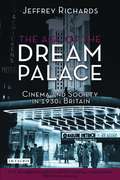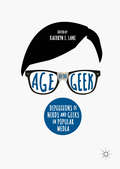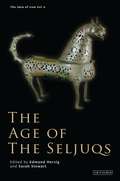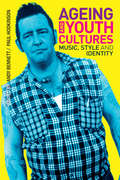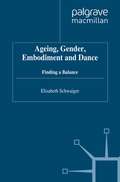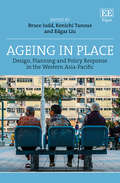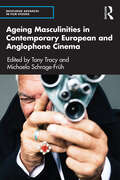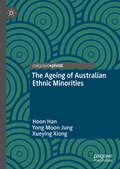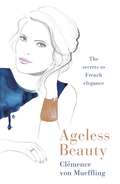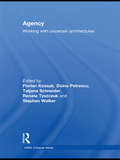- Table View
- List View
The Age of Glass: A Cultural History of Glass in Modern and Contemporary Architecture
by Stephen EskilsonGlass has long transformed the architectural landscape. From the Crystal Palace through to the towering glass spires of today's cities, few architectural materials have held such immense symbolic resonance in the modern era. The Age of Glass explores the cultural and technological ascension of glass in modern and contemporary architecture. Showing how the use of glass is driven as much by changing cultural concerns as it is by developments in technology and style, it traces the richly interwoven material, symbolic, and ideological histories of glass to show how it has produced and dispersed meaning in architecture over the past two centuries. The book's chapters focus on key moments within the modern history of architecture, moments when glass came to the forefront of architectural thought, and which illustrate how glass has been used at different times to project different cultural ideas. A wide range of topics are explored – from the tension between expressionism and functionalism, to the persistent theme of glass and social class, to how glass has reflected political ideas from Nazism through to today's global consumer capitalism. The book also grapples with current arguments about sustainability, while, taking into account the advent of digital LED screens and 'smart glass', offering new cultural perspectives on the future and asking what glass architecture will signify in the digital age. Combining close readings of buildings with insights drawn from research, plus good storytelling and strong contemporary relevance, The Age of Glass offers a fascinating new perspective on modern architecture and culture.
The Age of Glass: A Cultural History of Glass in Modern and Contemporary Architecture
by Stephen EskilsonGlass has long transformed the architectural landscape. From the Crystal Palace through to the towering glass spires of today's cities, few architectural materials have held such immense symbolic resonance in the modern era. The Age of Glass explores the cultural and technological ascension of glass in modern and contemporary architecture. Showing how the use of glass is driven as much by changing cultural concerns as it is by developments in technology and style, it traces the richly interwoven material, symbolic, and ideological histories of glass to show how it has produced and dispersed meaning in architecture over the past two centuries. The book's chapters focus on key moments within the modern history of architecture, moments when glass came to the forefront of architectural thought, and which illustrate how glass has been used at different times to project different cultural ideas. A wide range of topics are explored – from the tension between expressionism and functionalism, to the persistent theme of glass and social class, to how glass has reflected political ideas from Nazism through to today's global consumer capitalism. The book also grapples with current arguments about sustainability, while, taking into account the advent of digital LED screens and 'smart glass', offering new cultural perspectives on the future and asking what glass architecture will signify in the digital age. Combining close readings of buildings with insights drawn from research, plus good storytelling and strong contemporary relevance, The Age of Glass offers a fascinating new perspective on modern architecture and culture.
The age of internationalism and Belgium, 1880–1930: Peace, progress and prestige (PDF)
by Daniel LaquaBelgium was a major hub for transnational movements. By taking this small and yet significant European country as a focal point, the book critically examines major issues in modern history, including nationalism, colonial expansion, debates on the nature of international relations and campaigns for political and social equality. Now available in paperback, this study explores an age in which many groups and communities – from socialists to scientists – organised themselves across national borders. The timeframe covers the rise of international movements and associations before the First World War, the conflagration of 1914 and the emergence of new actors such as the League of Nations. The book acknowledges the changing framework for transnational activism, including its interplay with domestic politics and international institutions. By tracing international movements and ideas, the book aims to reveal and explain the multifarious and sometimes contradictory nature of internationalism.
The age of internationalism and Belgium, 1880–1930: Peace, progress and prestige
by Daniel LaquaBelgium was a major hub for transnational movements. By taking this small and yet significant European country as a focal point, the book critically examines major issues in modern history, including nationalism, colonial expansion, debates on the nature of international relations and campaigns for political and social equality. Now available in paperback, this study explores an age in which many groups and communities – from socialists to scientists – organised themselves across national borders. The timeframe covers the rise of international movements and associations before the First World War, the conflagration of 1914 and the emergence of new actors such as the League of Nations. The book acknowledges the changing framework for transnational activism, including its interplay with domestic politics and international institutions. By tracing international movements and ideas, the book aims to reveal and explain the multifarious and sometimes contradictory nature of internationalism.
The Age of New Waves: Art Cinema and the Staging of Globalization
by James TweedieThe Age of New Waves examines the origins of the concept of the "new wave" in 1950s France and the proliferation of new waves in world cinema over the past three decades. The book suggests that youth, cities, and the construction of a global market have been the catalysts for the cinematic new waves of the past half century. It begins by describing the enthusiastic engagement between French nouvelle vague filmmakers and a globalizing American cinema and culture during the modernization of France after World War II. It then charts the growing and ultimately explosive disenchantment with the aftermath of that massive social, economic, and spatial transformation in the late 1960s. Subsequent chapters focus on films and visual culture from Taiwan and contemporary mainland China during the 1980s and 1990s, and they link the recent propagation of new waves on the international film festival circuit to the "economic miracles" and consumer revolutions accompanying the process of globalization. While it travels from France to East Asia, the book follows the transnational movement of a particular model of cinema organized around mise en scène--or the interaction of bodies, objects, and spaces within the frame--rather than montage or narrative. The "master shot" style of directors like Hou Hsiao-Hsien, Tsai Ming-Liang, and Jia Zhangke has reinvented a crucial but overlooked tendency in new wave film, and this cinema of mise en scène has become a key aesthetic strategy for representing the changing relationships between people and the material world during the rise of a global market. The final chapter considers the interaction between two of the most global phenomena in recent film history--the transnational art cinema and Hollywood--and it searches for traces of an American New Wave.
The Age of New Waves: Art Cinema and the Staging of Globalization
by James TweedieThe Age of New Waves examines the origins of the concept of the "new wave" in 1950s France and the proliferation of new waves in world cinema over the past three decades. The book suggests that youth, cities, and the construction of a global market have been the catalysts for the cinematic new waves of the past half century. It begins by describing the enthusiastic engagement between French nouvelle vague filmmakers and a globalizing American cinema and culture during the modernization of France after World War II. It then charts the growing and ultimately explosive disenchantment with the aftermath of that massive social, economic, and spatial transformation in the late 1960s. Subsequent chapters focus on films and visual culture from Taiwan and contemporary mainland China during the 1980s and 1990s, and they link the recent propagation of new waves on the international film festival circuit to the "economic miracles" and consumer revolutions accompanying the process of globalization. While it travels from France to East Asia, the book follows the transnational movement of a particular model of cinema organized around mise en scène--or the interaction of bodies, objects, and spaces within the frame--rather than montage or narrative. The "master shot" style of directors like Hou Hsiao-Hsien, Tsai Ming-Liang, and Jia Zhangke has reinvented a crucial but overlooked tendency in new wave film, and this cinema of mise en scène has become a key aesthetic strategy for representing the changing relationships between people and the material world during the rise of a global market. The final chapter considers the interaction between two of the most global phenomena in recent film history--the transnational art cinema and Hollywood--and it searches for traces of an American New Wave.
The Age of Spectacle: Adventures in Architecture and the 21st-Century City
by Tom Dyckhoff'A great storyteller . . . you would be hard pushed to find a more knowledgeable or entertaining [guide]' Icon'Such an interesting book . . . I cannot recommend it enough.' Lauren LaverneIn Dubai, a luxury apartment block is built in the shape of a giant iPod. In China, President Xi Jinping denounces the trend of constructing ‘bizarre’ new buildings in wacky shapes and colours. In Cincinnati, celebrity architect Zaha Hadid is paid millions to design a single ‘iconic’ structure – with the hope of single-handedly transforming the region’s ailing fortunes. These incidents are all part of the same story: the rise of the age of spectacle.Over the last fifty years, there has been a revolution in how our cities operate. In The Age of Spectacle, Tom Dyckhoff tells the story of how architecture became obsessed with the flashy, the monumental and the ostentatious – and how we all have to live with the consequences. Exploring cityscapes from New York to Beijing, and from Bilbao to Portsmouth, Dyckhoff shows that we are not just witnessing a new kind of building: we are living through a fundamental transformation in how our urban spaces work. The corporate explosion of the last few decades has fundamentally shifted the relationship between architects, politicians and cities’ inhabitants, fostering innovative new kinds of engineering and design, but also facilitating ill-conceived vanity projects and commercial power-grabs.Timely, passionate and bursting with new ideas, The Age of Spectacle is both an examination of how twenty-first century cities work, and a manifesto for a radically new kind of urbanism. Our cities, Dyckhoff shows, can thrive in the age of spectacle – but only if they engage us not just with dazzling structures, but by responding to the needs of the people who inhabit them.'Engaging . . . The “iconic” building is the most obvious architectural phenomenon of our age yet, somehow, no one has quite done what Tom Dyckhoff does with The Age of Spectacle, which is to tell its story clearly and plainly.' Rowan Moore, Observer'First class. Finally, a book that nails the iconic movement – Tom Dyckhoff’s The Age of Spectacle is the book that I wish I had written.' Simon Jenkins'Unusually accessible [and] well argued.' Evening Standard
The Age of Static: How TV Explains Modern Britain
by Phil HarrisonYou can tell a lot about British society by its television. More than any other country, Britain still gets a sense of itself from the output of its national broadcasters. So what can we learn from the TV of the last two decades?Beginning in 2000, this book explores the televisual contours of Britain, via five themed chapters, taking in (among others) Big Brother, The Great British Bake Off, The Thick of It, The Apprentice, This Is England, Detectorists, Killing Eve and Fleabag. Over this period, Britain has become more divided and fractious, as populist politics began to inform the national conversation.What did Jamie’s School Dinners tell us about our perceptions of the working classes? What does our love of Downton Abbey say about the national psyche under duress? And how did Top Gear help to ignite Britain’s culture wars?In this lively and wide-ranging account of twenty tumultuous years, The Age of Static asks how we got here – and the role television played in the process.
The Age of Television: Experiences and Theories
by Milly Buonanno Jennifer RadiceAs television threatens to intrude upon our daily lives more than ever before, through cellular phones with broadcasting capabilities and thousands of new and previously unimaginable channels on digital TV, The Age of Television takes a careful look at the impact of this media form on modern life. Milly Buonanno analyzes the way in which televised entertainment has radically altered human perception of place and time, multiplied opportunities for indirect social experience, and fueled the collective imagination. Drawing on classic media theories but offering a fresh look at television’s dominance of Western culture, this book provides an optimistic perspective on the possibilities of the small screen.
The Age of the Avant-garde: 1956-1972
by Hilton KramerHilton Kramer, well known as perhaps the most perceptive, courageous, and influential art critic in America, is also the founder and co-editor (with Roger Kimball) of The New Criterion. This comprehensive book collects a sizable selection of his early essays and reviews published in Artforum, Commentary, Arts Magazine, The New York Review of Books, and The Times, and thus constituted his first complete statement about art and the art world.The principal focus is on the artists and movements of the last hundred years: the Age of the Avant-Garde that begins in the nineteenth century with Realism and Impressionism. Most of the major artists of this rich period, from Monet and Degas to Jackson Pollock and Claes Oldenburg, are discussed and often drastically revaluated. A brilliant introductory essay traces the rise and fall of the avant-garde as a historical phenomenon, and examines some of the cultural problems which the collapse of the avant-garde poses for the future of art. In addition, there are chapters on art critics, museums, the relation of avant-garde art to radical politics, and on the growth of photography as a fine art.This collection is not intended to be the last word on one of the greatest as well as one of the most complex periods in the history of the artistic imagination. The essays and reviews gathered here were written in response to particular occasions and for specific deadlines--in the conviction that a start in the arduous task of critical revaluation needed to be made, not because a critical theory prescribed it but because our experience compelled it!
The Age of the Avant-garde: 1956-1972
by Hilton KramerHilton Kramer, well known as perhaps the most perceptive, courageous, and influential art critic in America, is also the founder and co-editor (with Roger Kimball) of The New Criterion. This comprehensive book collects a sizable selection of his early essays and reviews published in Artforum, Commentary, Arts Magazine, The New York Review of Books, and The Times, and thus constituted his first complete statement about art and the art world.The principal focus is on the artists and movements of the last hundred years: the Age of the Avant-Garde that begins in the nineteenth century with Realism and Impressionism. Most of the major artists of this rich period, from Monet and Degas to Jackson Pollock and Claes Oldenburg, are discussed and often drastically revaluated. A brilliant introductory essay traces the rise and fall of the avant-garde as a historical phenomenon, and examines some of the cultural problems which the collapse of the avant-garde poses for the future of art. In addition, there are chapters on art critics, museums, the relation of avant-garde art to radical politics, and on the growth of photography as a fine art.This collection is not intended to be the last word on one of the greatest as well as one of the most complex periods in the history of the artistic imagination. The essays and reviews gathered here were written in response to particular occasions and for specific deadlines--in the conviction that a start in the arduous task of critical revaluation needed to be made, not because a critical theory prescribed it but because our experience compelled it!
The Age of the Dream Palace: Cinema and Society in 1930s Britain (Cinema and Society)
by Jeffrey RichardsThe period between the two world wars is often named "the golden age of the cinema" in Britain. This definitive and entertaining book on the cinema and cinema-goers of the era is herewith reissued with a new Introduction.Jeffrey Richards, described by Philip French as "a shrewd critic, a compulsive moviegoer, and a professional historian", tells the absorbing story of the cinema during the decade that produced Alfred Hitchcock's thrillers, the musicals of Jessie Matthews and Alexander Korda's epics. He examines the role of going to the pictures in people's lives during a tough period when, in the sumptuous buildings that housed local cinemas, people regularly spent a few pence to purchase ready-made dreams watching Gracie Fields, Robert Donat and the other stars of the day. He scrutinizes the film industry, censorship, cinema's influence, the nature of the star system and its images, as well as the films themselves, including the visions of Britain, British history and society that they created and represented."Jeffrey Richards is admirably equipped to look at the forces shaping the British film industry in the 1930s and to interpret sympathetically a body of films traditionally mocked for their class-bound attitudes… he is full of original insights and illuminating comparisons." - Philip French, 'Observer'"For those with an interest in British Cinema such an enthusiastic and knowledgeable book is a godsend." - Robert Murphy, 'Sight and Sound'
Age of the Geek: Depictions of Nerds and Geeks in Popular Media
by Kathryn E. LaneThis collection examines the nerd and/or geek stereotype in popular culture today. Utilizing the media—film, TV, YouTube, Twitter, fiction—that often defines daily lives, the contributors interrogate what it means to be labeled a “nerd” or “geek.” While the nerd/geek that is so easily recognized now is assuredly a twenty-first century construct, an examination of the terms’ history brings a greater understanding of their evolution. From sports to slasher films, Age of the Geek establishes a dialogue with texts as varied as the depictions of “nerd” or “geek” stereotypes.
Age of the Geek: Depictions of Nerds and Geeks in Popular Media
by Kathryn E. LaneThis collection examines the nerd and/or geek stereotype in popular culture today. Utilizing the media—film, TV, YouTube, Twitter, fiction—that often defines daily lives, the contributors interrogate what it means to be labeled a “nerd” or “geek.” While the nerd/geek that is so easily recognized now is assuredly a twenty-first century construct, an examination of the terms’ history brings a greater understanding of their evolution. From sports to slasher films, Age of the Geek establishes a dialogue with texts as varied as the depictions of “nerd” or “geek” stereotypes.
The Age of the Seljuqs: The Idea Of Iran (The Idea of Iran)
by Edmund Herzig Sarah StewartFrom their ancestral heartland by the shores of the Aral Sea, the medieval Oghuz Turks marched westwards in search of dominion. Their conquests led to control of a Muslim empire that united the territories of the eastern Islamic world, melded Turkic and Persian influences and transported Persian culture to Anatolia. In the eleventh and twelfth centuries the new Turkic-Persian symbiosis that had earlier emerged under the Samanids, Ghaznavids and Qara-Khanids came to fruition in a period that, under the enlightened rule of the Seljuq dynasty, combined imperial grandeur with remarkable artistic achievement. This latest volume in The Idea of Iran series focuses on a system of government based on Turkic 'men of the sword' and Persian 'men of the pen' that the Seljuqs (famous foes of the Crusader Frankish knights) consolidated in a form that endured for centuries. The book further explores key topics relating to the innovative Seljuq era, including: conflicted Sunni-Shi'a relations between the Sunni Seljuq empire and Ismaili Fatimid caliphate; art, culture and ceramics; and poetry and architecture.
Ageing and Youth Cultures: Music, Style and Identity
by Andy Bennett Paul HodkinsonWhat happens to punks, clubbers, goths, riot grrls, soulies, break-dancers and queer scene participants as they become older? For decades, research on spectacular 'youth cultures' has understood such groups as adolescent phenomena and assumed that involvement ceases with the onset of adulthood. In an age of increasingly complex life trajectories, Ageing and Youth Cultures is the first anthology to challenge such thinking by examining the lives of those who continue to participate into adulthood and middle-age. Showcasing a range of original research case studies from across the globe, the chapters explore how participants reconcile their continuing involvement with ageing bodies, older identities and adult responsibilities. Breaking new ground and establishing a new field of study, the book will be essential reading for students and scholars researching or studying questions of youth, fashion, popular music and identity across a wide range of disciplines.
Ageing and Youth Cultures: Music, Style and Identity
by Paul Hodkinson Andy BennettWhat happens to punks, clubbers, goths, riot grrls, soulies, break-dancers and queer scene participants as they become older? For decades, research on spectacular 'youth cultures' has understood such groups as adolescent phenomena and assumed that involvement ceases with the onset of adulthood. In an age of increasingly complex life trajectories, Ageing and Youth Cultures is the first anthology to challenge such thinking by examining the lives of those who continue to participate into adulthood and middle-age. Showcasing a range of original research case studies from across the globe, the chapters explore how participants reconcile their continuing involvement with ageing bodies, older identities and adult responsibilities. Breaking new ground and establishing a new field of study, the book will be essential reading for students and scholars researching or studying questions of youth, fashion, popular music and identity across a wide range of disciplines.
Ageing, Gender, Embodiment and Dance: Finding a Balance
by E. SchwaigerThis book explores the nexus between gender, ageing and culture in dancers practicing a variety of genres. It challenges existing cultural norms which equate ageing with bodily decline and draws on an interdisciplinary theoretical framework to explore alternatives for developing a culturally valued mature subjectivity through the practice of dance.
Ageing in Place: Design, Planning and Policy Response in the Western Asia-Pacific
Encouraging older people to age in place in their own homes is a common response internationally to the economic and social demands of population ageing. It is recognized that the nature of the built environment at various scales is critical to optimizing the social participation and wellbeing of older people and hence in facilitating ageing in place. This insightful book showcases a range of design, planning and policy responses to ageing populations from across the rapidly changing and dynamic Western Asia-Pacific region. Ageing in Place considers diverse cultural, political and environmental contexts and responses to show that regional governments, industries and communities can gain, as well as offer, important insights from their international counterparts. With significant changes in caring, family dynamics and the supporting roles of governments in both Eastern and Western societies, the chapters demonstrate a clear and increasingly convergent preference for and promotion of ageing in place and the need for collaborative efforts to facilitate this through policy and practice. The unique geographical focus and multi-disciplinary perspective of this book will greatly benefit academic researchers and students from a variety of backgrounds including architecture, urban planning, sociology and human geography. It also provides a unique entry point for practitioners seeking to understand the principles of design and practice for ageing in place in homes, neighbourhoods and care facilities.
Ageing Masculinities in Contemporary European and Anglophone Cinema (Routledge Advances in Film Studies)
by Tony Tracy Michaela Schrage-FrühThis volume offers a unique exploration of how ageing masculinities are constructed and represented in contemporary international cinema. With chapters spanning a range of national cinemas, the primarily European focus of the book is juxtaposed with analysis of the social and cultural constructions of manhood and the "anti-ageing" impulses of male stardom in contemporary Hollywood. These themes are inflected in different ways throughout the volume, from considering how old age is not the monolithic and unified life stage with which it is often framed, to exploring issues of queerness, sexuality, and asexuality, as well as themes such as national cinema and dementia. Offering a diverse and multifaceted portrait of ageing and masculinity in contemporary cinema, this book will be of interest to scholars and students of film and screen studies, gender and masculinity studies, and cultural gerontology.
Ageing Masculinities in Contemporary European and Anglophone Cinema (Routledge Advances in Film Studies)
by Tony Tracy Michaela Schrage-ÜhThis volume offers a unique exploration of how ageing masculinities are constructed and represented in contemporary international cinema. With chapters spanning a range of national cinemas, the primarily European focus of the book is juxtaposed with analysis of the social and cultural constructions of manhood and the "anti-ageing" impulses of male stardom in contemporary Hollywood. These themes are inflected in different ways throughout the volume, from considering how old age is not the monolithic and unified life stage with which it is often framed, to exploring issues of queerness, sexuality, and asexuality, as well as themes such as national cinema and dementia. Offering a diverse and multifaceted portrait of ageing and masculinity in contemporary cinema, this book will be of interest to scholars and students of film and screen studies, gender and masculinity studies, and cultural gerontology.
The Ageing of Australian Ethnic Minorities
by Hoon Han Yong Moon Jung Xueying XiongThis book provides a comprehensive view of the quality of life of older people from culturally and linguistically diverse (CALD) backgrounds living in Australia.The book is unique and significant because the descriptions and arguments presented are based on the lived experience and hence provide deep insights into the complexity and dynamics of CALD older migrants. Key areas of exploration include social connectedness and inclusion, post-retirement economic activities, living arrangement and housing choice, practice of care, intergenerational exchange, and life satisfaction. A focus is placed on the diversity of ageing experience. Pathways of ageing are one of the key factors in investigating inter and intra-ethnic commonalities and disparities. The policy and research implications presented will appeal to policy makers, practitioners and researchers.
Ageless Beauty: Discover the best-kept beauty secrets from the editors at Vogue Paris
by Clemence Von MuefflingDiscover the best-kept beauty secrets from three generations of editors and experts at Vogue Paris . . . ------------- Your guide to French beauty lets you in on . . . · Essential advice on how to make simple changes to your beauty habits, from the correct way to wash your hair to the vital items no make-up bag should be without.· How to give your skin a healthy glow in just a few simple steps.· Advice for women of all ages, Jeunesse, Plenitude and Maturite, to ensure energy, confidence and happiness.· Which self-tanners to use and how to apply for a beautiful, healthy, summer tan.· The four pillars of French wellness: food, posture, exercise and movement you need and dormez-vous. · And much more . . . Clémence Von Mueffling draws on her family's wisdom and passion to show how you can achieve effortless French beauty at any age. Filled with tips, intimate anecdotes and expert interviews, Ageless Beauty is sure to become every woman's definitive beauty guide. ------------- 'A delicious dose of effortless chic, timeless glamour, priceless beauty secrets, self-care and self-confidence' Sarah Brown, former Beauty Director, Vogue'This book is a magical guide, with expert advice in three categories so women of all ages will feel it is specifically tailored to them' Aerin Lauder, Style and Image Director of Estee Lauder
Agency: Working With Uncertain Architectures
by Florian Kossak Doina Petrescu Tatjana Schneider Renata Tyszczuk Stephen WalkerWhile the potential of agency is most frequently taken to be the power and freedom to act for oneself, for the architectural community this also involves the power and responsibility to act as intermediaries on behalf of others. Presenting current thinking from practitioners and scholars from around the world, this book asks for a more active relationship between the humanities, the architectural profession, and society. Considering issues of architectural research as an agency of transformation, this book explores how humanities research can better contribute towards understanding current architectural needs.
Agency: Working With Uncertain Architectures
by Florian Kossak Doina Petrescu Tatjana Schneider Renata Tyszczuk Stephen WalkerWhile the potential of agency is most frequently taken to be the power and freedom to act for oneself, for the architectural community this also involves the power and responsibility to act as intermediaries on behalf of others. Presenting current thinking from practitioners and scholars from around the world, this book asks for a more active relationship between the humanities, the architectural profession, and society. Considering issues of architectural research as an agency of transformation, this book explores how humanities research can better contribute towards understanding current architectural needs.
